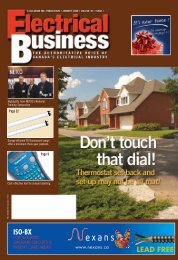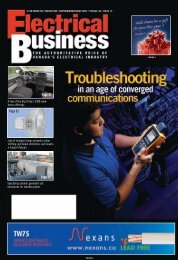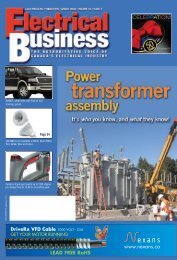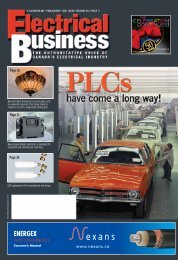Download - Electrical Business Magazine
Download - Electrical Business Magazine
Download - Electrical Business Magazine
Create successful ePaper yourself
Turn your PDF publications into a flip-book with our unique Google optimized e-Paper software.
mind your safetyI do not espouse knee-jerk reactions,but I’m all for some kind of reaction...to be 1.2 cal then, as you move closer tothe source, the incident energy would—theoretically—increase by the inverse ofthe distance squared (1 ÷ distance ratio 2 ).So at 9 in., the distance decreases by half(9 in. versus 18 in.), and the incidentenergy shoots up to 4.8 cal. At 5 in., theincident energy rockets up to 15.6 cal!These distances are easily achieved whenyou lean forward to take a close look atsomething while troubleshooting anenergized circuit. When that happens,trust me—your exposure is no longer amere 1.2 cal.In addition, when you are workingdownstream from an older circuit breakerthat’s out of spec, you would have no idea:a) how fast that circuit breaker wouldactually operate, or b) whether it actuallycan operate.Several years ago, members of NETA(InterNational <strong>Electrical</strong> TestingAssociation) conducted a study in whichthey performed tests on 34,000 circuitbreakers; of those, 10.5% did not operateat all, and a further 23% did not openwithin their specifications.This means that 33.5% of 34,000breakers would constitute a serious hazardto any worker working downstream who isalso relying on an arc flash hazard studythat says 1.2 cal or task tables indicatingCategory 0.So why is this 15-cal video clip valid?Because 1.2 cal at 18 in. and 2 cycles ofclearing time becomes 19.2 cal by leaningin within 9 in. of equipment protected bya device that takes 8 cycles to open.There is chaos and uncertainty withinall of the arc flash work we do. Ourequipment is getting older and older. Youknow the age of the equipment you faceevery day, and you know the last time itwas properly maintained. Even when yougo into a facility whose maintenancehistory is a mystery, it does not take youvery long to get an understanding of whatit looks like, smells like, feels like andsounds like.In truth, I am astounded that anyonewould be react negatively to that column; itis a slam dunk that you do not wear meltingmaterials on your body when you may beexposed to energized electrical systems. Ido not espouse knee-jerk reactions, but I’mall for some kind of reaction... preferably onethat leads to action.Let’s face it... every safety interventionhas had its opponents and detractors:steel-toed boots are too heavy; hard hatsmake you bang your head; safety eyewearis a scratchy waste of time; gloves are bulky; FRclothing is hot; if we do this, our productivity willsuffer... ad infinitum, ad nauseam!Kurt Lewin’s Force Field Analysis shows that, forevery good intention, there will be a force thatopposes it, and the former must possess greaterforce to override the negativity of the latter. It hastaken many deaths, disfigurements and amputationsto get electrical safety to where it is today.But there’s more to do.Arc flash danger is based on time, current anddistance, and to turn a 1.2-cal danger into a 15-calflash, it takes two things: move in closer, and havea poorly operating protective device. Regardless, ifit can melt (like the foam insert), keep it awayfrom your electrical systems.Until next time, be ready, be careful and besafe.©Canada Training Group has been providing consultingservices to industry since 1980; Dave Smith, thepresident, can be reached at davesmith@canadatraining-group.ca.At www.canada-training-group.ca,you will find this article (and others) available to you.Feel free to use them to support your own safetyprogram and other initiatives.A pioneer in the design of teck cablefittings, the Thomas & BettsSTAR TECK ® product line remainsan indisputable industry standard tothis day.All STAR TECK ® fittings are designedand manufactured in Canada forCanada.STAR TECK ® cable fittings.A tradition of industry firsts.CTG_EB_March10.indd 12/16/10 10:01:21 T&B_vert_EB_April10.indd AM1www.EBMag.com • April 2010 • 113/9/10 2:02:58 PM

















